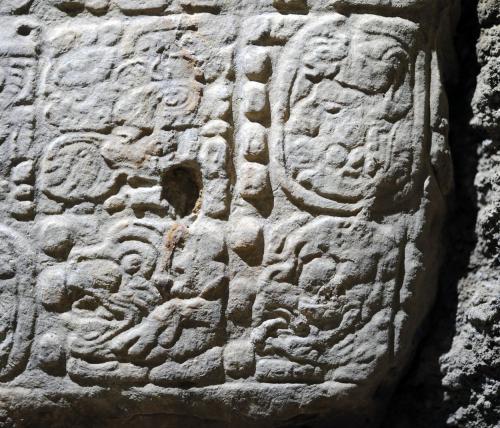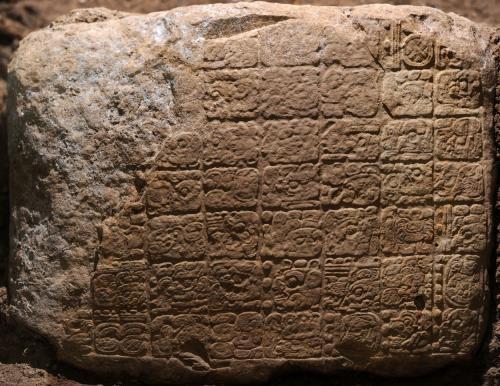Tulane University
Source - http://phys.org/news/2012-06-maya-archaeologists-unearth-monument.html

Archaeologists working at the site of La Corona in Guatemala have discovered a 1,300 year-old year-old Maya text that provides only the second known reference to the so-called “end date” for the Maya calendar on December 21, 2012. The discovery, one of the most significant hieroglyphic find in decades, was announced today at the National Palace in Guatemala.
“This text talks about ancient political history rather than prophecy,” says Marcello A. Canuto, Director of Tulane’s Middle American Research Institute and co-director of the excavations at the Maya ruins of La Corona. “This new evidence suggests that the 13 Bak’tun date was an important calendrical event that would have been celebrated by the ancient Maya; however, they make no apocalyptic prophecies whatsoever regarding the date," says Canuto.
La Corona for many decades has been known as the enigmatic “Site Q,” the source of many looted sculptures whose whereabouts had remained a mystery until its rediscovery only fifteen years ago. For the past five years, Marcello A. Canuto and Tomás Barrientos Q. (Director of the Centro de Investigaciones Arqueológicas y Antropológicas at Universidad del Valle de Guatemala) have directed the La Corona Regional Archaeological Project (PRALC) which has been investigating this intriguing Classic Maya city and its jungle environs.
In 2012, Canuto and Barrientos decided to excavate in front of a building that had been heavily damaged nearly 40 years ago by looters looking for carved stones and tombs. “Last year, we realized that looters of a particular building had discarded some carved stones because they were too eroded to sell on the antiquities black market,” said co-director Barrientos, “so we knew they found something important, but we also thought they might have missed something.” In fact, in 2012, excavations not only recovered 10 more discarded hieroglyphic stones but also something that the looters missed entirely—an untouched step with a set of 12 exquisitely carved stones still in their original location (in total, 22 carved stones were recovered). Combined with the known looted blocks, the original staircase had a total of no less than 264 hieroglyphs, making it one of the longest ancient Maya texts known, and the longest in Guatemala.

While the archaeological team investigated when and how this particular staircase was built, Dr. David Stuart, director of the Mesoamerica Center of the University of Texas at Austin undertook the decipherment of the many new hieroglyphic texts. Stuart was part of the first archaeological expedition to La Corona in 1997, and has been reading and reconstructing the site’s history ever since. The stairway inscription relates 200-years’ worth of political history of La Corona, its allies, and its enemies. Consistent with these themes, some of these stones portray rulers in various poses accepting tribute, dancing, and preparing to play the Maya ballgame.
Another entirely unexpected discovery was made on another stairway block bearing 56 delicately carved hieroglyphs. Stuart recognized that it commemorated a royal visit to La Corona in AD 696 by the most powerful Maya ruler of that time, Yuknoom Yich’aak K’ahk’ of Calakmul (located in modern Campeche, Mexico), also known as Fire Claw or Jaguar Paw. Calakmul had been an immensely powerful kingdom for centuries until its king was defeated in battle by his longstanding rival Tikal (located in modern Peten, Guatemala) on August 3, 695. “Scholars had assumed that the Calakmul king died or was captured in this engagement” says Stuart, “but this new extraordinary text from La Corona text tells us otherwise.”

It turns out that the defeated Calakmul king was neither killed nor captured; in fact, in the wake of his inglorious defeat, he was visiting La Corona and perhaps other trusted allies to allay their fears after his defeat. Why the reference to the year 2012? Does it provide a prophecy of what is to come? No, the reference to this important date has much more to do with events in the 7th rather than 21st century.
The key to understanding the reference to 2012 is a unique title that this Calakmul king gives himself. In the text, he calls himself the “13 K’atun lord”—that is, the king who presided over and celebrated an important calendar ending, the 13th K’atun cycle (9.13.0.0.0). This event had occurred just a few years before in AD 692. In order to vaunt himself even further and place his reign and accomplishments into an eternal setting, he connects himself forward in time to when the next higher period of the Maya calendar would reach the same 13 number—that is, December 21, 2012 (13.0.0.0.0).

Rather than prophesy, the 2012 reference served to place this king’s troubled reign and accomplishments into a larger cosmological framework. “This was a time of great political turmoil in the Maya region and this king felt compelled to allude to a larger cycle of time that happens to end in 2012,” says Stuart. This evidence is consistent with the only other reference to the 2012 date in ancient Maya inscriptions—Monument 6 from Tortuguero, Mexico. “What this text shows us is that in times of crisis, the ancient Maya used their calendar to promote continuity and stability rather than predict apocalypse,” says Canuto.
The project continues to study and record these newly carved stones, others of which record other important episodes of ancient Maya history. Furthermore, the project plans to continue to fieldwork at La Corona, directed by Tulane University and the Universidad del Valle de Guatemala, supported by the Ministry of Culture of Guatemala
More information: Images (c) Tulane University.